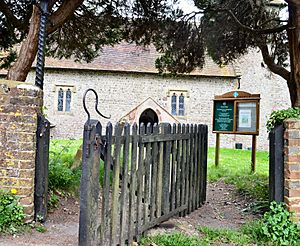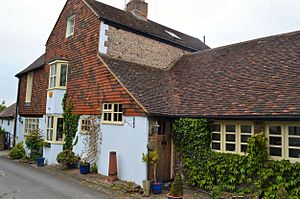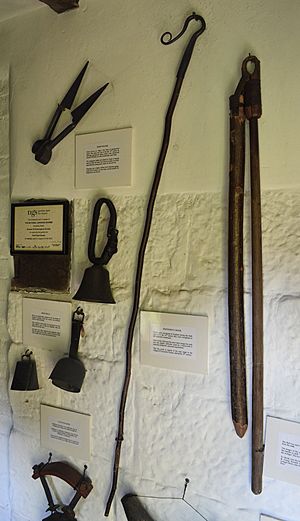Pyecombe hook facts for kids
A Pyecombe hook is a unique type of shepherd's crook. It was made in the old forge in the village of Pyecombe in Sussex, England. These hooks have been crafted there since the 1800s.
The Pyecombe hook was designed to be perfectly balanced. It had a special twist that helped shepherds easily catch a sheep's back leg without hurting the animal. One person, Charles Mitchell, explained it well: "the curve is made so that the shepherd can hook it around the sheep’s leg, slide it up, give it a slight twist, and the sheep is caught fast without being in the least hurt." These hooks were often made from old gun barrels, making them very strong.
Contents
The History of the Pyecombe Hook
The village of Pyecombe is located on an old drove road on the South Downs. This area has a long history of shepherding. The Pyecombe hook became very popular among shepherds in Sussex and was used for about 200 years.
Where Were They Made?
The first Pyecombe hooks were made in the early 1800s by a blacksmith named Mr. Berry. He worked in the old forge in Pyecombe, which is now a private house.
After Mr. Berry, Mr. Charles Mitchell took over the forge. He continued making the hooks from 1872 to 1946. The very last blacksmith at the forge, Mr. Sean Black, made a special ceremonial Pyecombe hook in 1946. This hook is now kept at the Pyecombe church.
Where Can You See a Pyecombe Hook Today?
You can still see examples of these historic tools today.
- One Pyecombe hook is part of the Tapsel gate at the entrance to the churchyard of Pyecombe church.
- The Pyecombe hook is also shown on the Pyecombe village sign.
- There is an example of a Pyecombe hook at the Sussex Archaeological Society's Museum in Lewes.
The Pyecombe Hook in Song
The Pyecombe hook was so important that it was even celebrated in a song!




